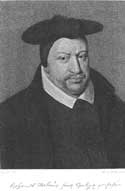Joannes Molanus facts for kids
Joannes Molanus (1533–1585) was a very important Catholic religious scholar. His real name was Jan Vermeulen or Van der Meulen. He used the Latinized name Molanus for his writings.
He was a professor of theology at Louvain University in Belgium. He also served as the university's leader, called a Rector, starting in 1578. Molanus was born in Lille, a city that was part of the Habsburg lands at the time. He was also a priest and a canon at St. Peter's Church in Leuven, where he later passed away.
Molanus wrote many books, some of which were published after his death. He is most famous for his book De Picturis et Imaginibus Sacris. This means "Treatise on Sacred Images." It came out in 1570, just four years after a period of widespread destruction of religious art called the Iconoclastic Fury in the Low Countries.
In his book, Molanus defended the use of religious images. However, he also strongly enforced new rules from the Council of Trent. These rules aimed to guide how religious art should be made and used. His ideas were very influential. His book was reprinted many times, and a modern French translation was made in 1996.
He also helped edit the works of Saint Augustine, a very important early Christian thinker. This large project was published between 1566 and 1577. Molanus also wrote a history of Louvain University, which was printed in 1861.
Life of Joannes Molanus
Molanus was born in Lille, in a region called Walloon Flanders, in 1533. His father was Hendrik Vermeulen, and his mother was Anna Peters. His father came from Holland, and his mother was from Brabant.
He started studying at Louvain University on February 27, 1554. He earned his degree in Liberal Arts in 1558. Then, he became a Doctor of Theology in 1570.
Molanus was part of a group of scholars who checked and updated the Leuven Vulgate. This was an important Latin version of the Bible, published in 1574. He became a canon at St. Peter's Church in Leuven. He also taught theology as a professor.
He held several important leadership roles at the university. He was the dean of the Faculty of Theology. He also served as the rector, or head, of the entire university. In 1579, he was made president of King's College.
Joannes Molanus died in Louvain on September 18, 1585. He left money and gifts to the college he had led.
Molanus and Religious Art
Today, art historians remember Molanus for his strong influence on religious art. He was one of the first people to take the general rules about sacred images from the Council of Trent (1563) and turn them into very detailed instructions for artists. These instructions were then widely followed in Catholic countries.
Molanus believed that religious art should be accurate and respectful. He had specific objections to certain popular images:
- He did not like paintings showing the Death of the Virgin Mary.
- He also objected to Mary fainting at the foot of the Cross.
- He didn't want Mary shown asking Christ for help in Last Judgement scenes.
He also disapproved of other images that were not based on reliable sources, like the Bible. These included:
- Saint Christopher shown as a giant carrying Christ.
- The story of Saint George and the Dragon.
- The Holy Kinship (showing Jesus's extended family).
- The unicorn hunt in the Hortus Conclusus (a garden scene).
Molanus said that popular stories like the Golden Legend were not reliable. He called them "lead" instead of "gold."
While he criticized older images without a clear basis, he also suggested new ways to show religious figures. For example, he believed Saint Joseph should not be shown as an old, funny figure, as was common in the Middle Ages. Instead, Molanus wanted Joseph to appear young, strong, and clearly in charge of the Holy Family. He also continued to oppose showing the Swooning Virgin Mary in scenes like Christ carrying the Cross or the Crucifixion.
Publications
Molanus wrote many important books and treatises. Here are some of his notable works:
- Usuardi martyrologium (Leuven, 1568) Available on Google Books
- De Picturis et Imaginibus Sacris (Leuven, 1570) Available on Google Books
- This book was later rewritten and published after his death as Historia Sanctarum Imaginum (Leuven, 1594) Available on Google Books
- Indiculus Sanctorum Belgii (Leuven, 1573) Available on Google Books
- De fide haereticis servanda libri tres (Cologne, 1584) Available on Google Books
- Theologiae Practicae Compendium (Cologne, 1585) Available on Google Books
- Liber de piis testamentis (Cologne, 1585) Available on Google Books
- De Canonicis libri tres (Cologne, 1587) Available on Google Books
- Militia sacra ducum et principum Brabantiae (Antwerp, 1592), published after his death; available on Google Books
- Natales sanctorum Belgii (Antwerp, 1595), published after his death; available on Google Books
See also
 In Spanish: Johannes Molanus para niños
In Spanish: Johannes Molanus para niños


